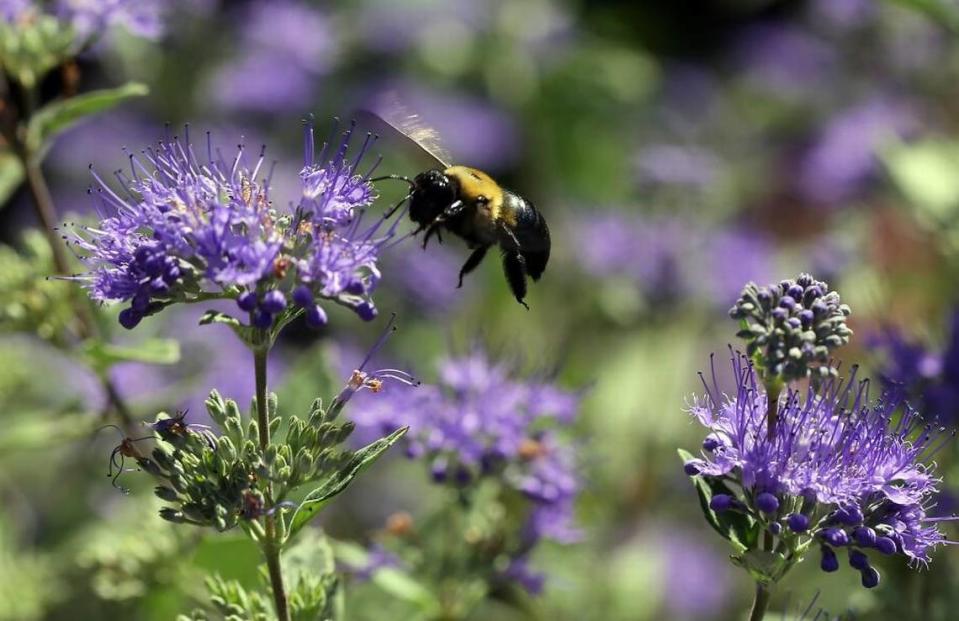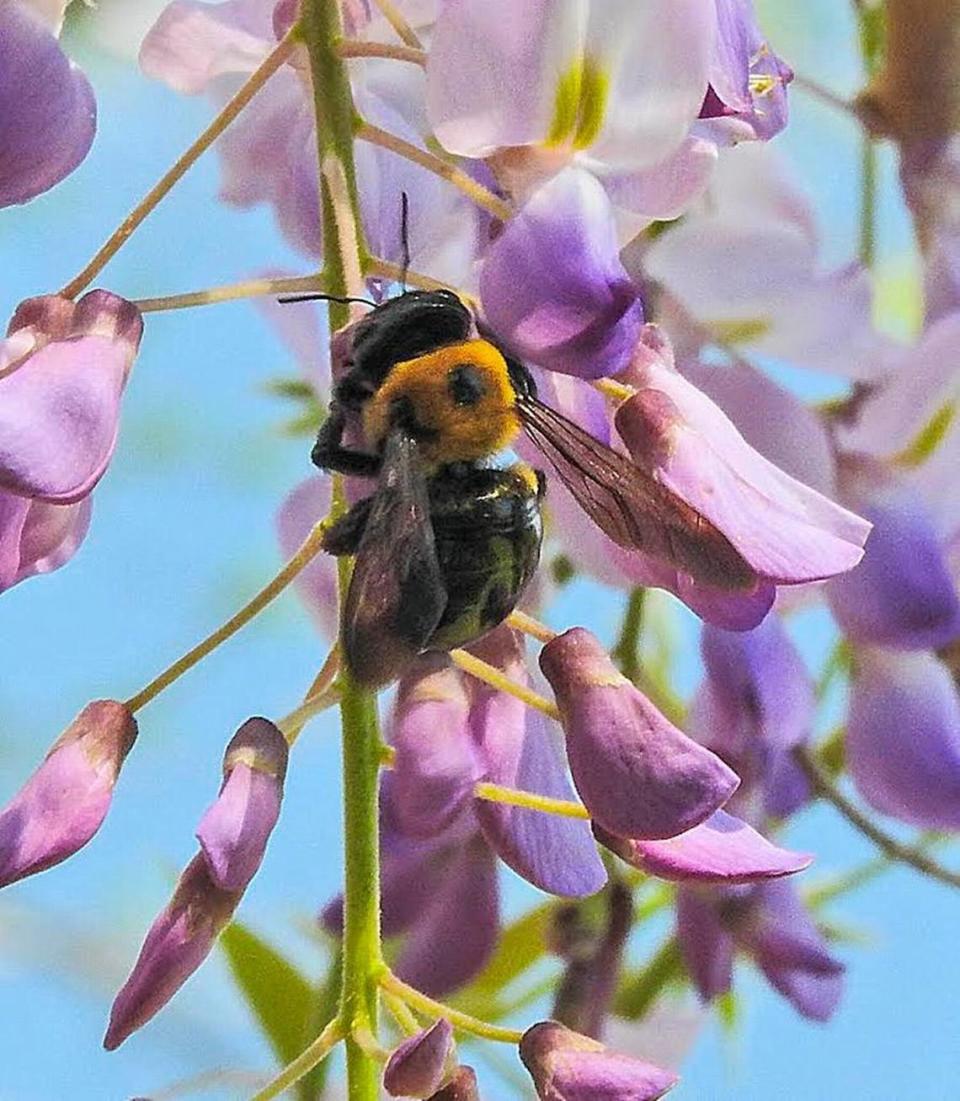Carpenter bees can be a spring buzzkill. Here’s how to get rid of them (or coexist)
Carpenter bees are buzzing busily this time of year in North Carolina, coming out of their nests to mate and pollinate — and drill holes in our porches and decks to make next year’s habitat.
Not to be confused with a bumblebee, a carpenter bee is large with a black, hairless tail section. They are aptly are named because of their strong jaws, which they use to dig out tunnels in wood.
Because of their drilling, some people don’t like them hanging around.
We found out more about carpenter bees in (literally inside the structure of) your home and got some expert advice for getting rid of them:
What are carpenter bees?
Carpenter bees are solitary bees, which means they do not form colonies and live with other bees.
Instead, female bees build tunnels inside of wood — it can be a tree in nature or a wooden deck in a residential neighborhood — to gather pollen and lay their eggs. The bees typically return to the same tunnel year after year.

Here’s what else you should know about carpenter bees:
▪ They’re good pollinators: Great news for backyard gardeners!
“Carpenter bees tend to be more effective pollinators of larger or flatter flowers, like fruit trees, tulip trees and, most especially, passionfruits (including our local native, the maypop or purple passionflower),” Elsa Youngsteadt, an assistant professor in NC State’s Department of Applied Ecology, told The News & Observer.
They have short mouthparts and must bite through tubular flowers to get to the nectar, so they transfer less pollen than other bees, like bumblebees, she said.
“The main point I like to make is that carpenter bees are pollinators,” Hannah K. Levenson, a postdoctoral research scholar at NC State’s Department of Entomology and Plant Pathology, told The N&O.
“If carpenter bees are present in someone’s yard that means they are providing a good habitat for them, which some could take as a compliment!”
▪ Males don’t sting: Males do not have stingers, and female bees will not sting you unless they’re confined in your hand or incredibly agitated.
Males will buzz loudly, which can be intimidating, though with no stinger, they can’t do any physical damage. The rare female carpenter bee’s sting can be a bad one.
▪ They’re a necessary part of NC’s ecosystem: “Carpenter bees are pollinators and are a part of our ecosystem,” Levenson said. “I do not mind when carpenter bees are in my garden. They are generalist pollinators, so they will pollinate many flowers in people’s gardens, as well as in our natural areas, including wild flowering plants.
“They are particularly good pollinators of passion fruit, and we have a couple native species of passion fruit here in NC, so they are important for those plant species. While I understand that many people are concerned about them nesting in wooden structures, I personally do not share the sentiment. I built a wooden bench last year and was happy that a female carpenter bee quickly made a nest and moved in!”
▪ They sleep all winter and buzz all spring: “Carpenter bees are unique in that they overwinter as adults,” Levenson said. “Many of our other native bee species do not do this. In early spring (think now!) adult females and males come out of their nests and mate. That is when people will observe males guarding their territory. That only lasts for a few weeks, at which point the females will lay their eggs in the nests. These eggs will then develop to a larvae, then a pupae, then an adult through the rest of the year. These new adults will overwinter as adults and start the whole cycle over again.”
Many bees share a single nest in the winter, but in the spring, they split up. One female “owns” each nest, collects pollen and lays eggs, Youngsteadt said. She may let one or two other females hang out with her in the nest, but they rarely do much collecting or egg laying. Usually, those “extras” wait until the following year to make their own nests.
For a life cycle diagram of the carpenter bee (and other big bees), visit cals.ncsu.edu/applied-ecology.
▪ They’re woodpecker snacks: Woodpeckers love to eat carpenter bee larvae, meaning woodpeckers will seek (and peck) out carpenter bee nests.
“For many homeowners, the holes where a woodpecker opens a bee tunnel are just as (or more) concerning than the original bee tunnels themselves,” Youngsteadt said. “So it’s great to provide woodpecker food, but a bummer that the woodpeckers contribute to the damage!”
For more information on carpenter bees, visit content.ces.ncsu.edu/carpenter-bees and union.ces.ncsu.edu.

How to safely get rid of carpenter bees
The carpenter bee problem is a difficult one to handle.
Since they’re solitary, you can’t kill off a full nest at once. And since the bees only chew through wood (without eating it), you can’t apply poisons that will be ingested.
“The main methods available to kill carpenter bees include using pesticides or other chemicals and applying them to the nest,” Levenson said.
But this can be harmful for the other bees that help make NC an agricultural goldmine, and is not recommended.
“I dislike recommending insecticide use,” Youngsteadt said. “We don’t need more bee-toxic substances in the environment when we have so many other species of bees that we are trying to support!”
Donna Teasley, a NC State Extension agent out of Burke County, has a couple ways of getting rid of carpenter bees:
• Puff sevin dust into carpenter bee tunnels while bees are nesting. Seal up the holes with caulk. Doing this will kill next year’s population when they hatch. Youngsteadt said this should be done in the evening when bees are in their nests.
• Swat bees with a badminton racket, as the bees die easily.
For more information, visit burke.ces.ncsu.edu/carpenter-bees.
Redirect the carpenter bee’s attention
A YouTube video done by Science with Mr. Harris (which Levenson endorsed) shares some tips to make carpenter bees build their nests in places that aren’t your home. (Remember, these tips aren’t foolproof, and they don’t work in every single situation.)
• Plug up holes, that way carpenter bees have to choose a new place to dig next year. Hopefully, it’ll be a more convenient place for you and your family.
“The bees re-use nests year after year, extending and remodeling a little bit each year,” Youngsteadt said.
• Provide unvarnished, soft wood in your yard, which carpenter bees love. They’ll likely dig into this instead of your back porch. After the holes have been drilled, you can move the wood away from your yard.
• Paint/varnish all areas outside of your home, since the bees won’t go near places that don’t look like raw wood
Watch the video for yourself to learn more about carpenter bees and how to get them out of your yard:
If you have questions about insect management, you can contact your county’s NC State Extension office and get connected with an expert. To find your local office, visit ces.ncsu.edu/local-county-center.

